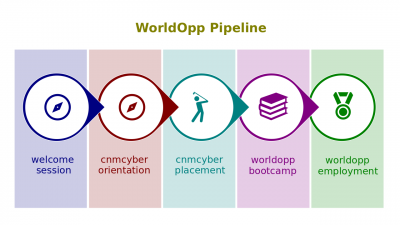Difference between revisions of "Educational Institutions"
(→Script) |
|||
| Line 24: | Line 24: | ||
:[[Vocational school]] ([[trade school]], [[career center]], or [[vocational college]]). An [[educational institution]] that facilitates [[learning]] beyond [[compulsory education]], but does not award [[academic credential]]s higher than [[high school diploma]]s. Instead, [[vocational school]]s concentrate on those [[occupation]]s that do not require advanced [[academic credential]]s and those [[KSA]]s that are needed to start working in those [[occupation]]s. | :[[Vocational school]] ([[trade school]], [[career center]], or [[vocational college]]). An [[educational institution]] that facilitates [[learning]] beyond [[compulsory education]], but does not award [[academic credential]]s higher than [[high school diploma]]s. Instead, [[vocational school]]s concentrate on those [[occupation]]s that do not require advanced [[academic credential]]s and those [[KSA]]s that are needed to start working in those [[occupation]]s. | ||
| − | '''[[ | + | '''[[Educational Institutions]]''' is the successor [[lectio]]. |
==Quiz== | ==Quiz== | ||
Revision as of 15:57, 10 May 2020
Educational Institutions (hereinafter, the Lectio) is the second lesson part of the Certifications of Study lesson that introduces its participants to educational service providers and related topics.
This lesson belongs to the Introduction to Education session of the CNM Cyber Orientation. The Orientation is the second stage of the WorldOpp Pipeline.
Contents
Content
The predecessor lectio is Credentialing Bodies.
Key terms
- Educational institution. An enterprise, usually an organization or its constituent part, that exists to provide the public with education.
- Preschool (nursery school, kindergarten). An educational institution that offers early childhood education to children before they begin compulsory education at primary school.
- Elementary school (primary school). An educational institution that offers initial or primary compulsory education, in the United States and Canada, from the age of about seven to twelve. Students usually attend elementary school after preschool and before secondary school.
- Secondary school (in the United States, a combination of middle school and high school). An educational institution that offers compulsory education beyond its primary level that is offered at elementary school. In the United States and Canada, the students of secondary schools are from the age of about twelve to eighteen.
- Tertiary school (college, university, post-secondary school). An educational institution that facilitates learning beyond compulsory education and awards academic credentials higher than high school diplomas.
- Vocational school (trade school, career center, or vocational college). An educational institution that facilitates learning beyond compulsory education, but does not award academic credentials higher than high school diplomas. Instead, vocational schools concentrate on those occupations that do not require advanced academic credentials and those KSAs that are needed to start working in those occupations.
Script
Educational institution. An enterprise, usually an organization or its constituent part, that exists to provide the public with education.
- Preschool (nursery school, kindergarten). An educational institution that offers early childhood education to children before they begin compulsory education at primary school.
- Elementary school (primary school). An educational institution that offers initial or primary compulsory education, in the United States and Canada, from the age of about seven to twelve. Students usually attend elementary school after preschool and before secondary school.
- Secondary school (in the United States, a combination of middle school and high school). An educational institution that offers compulsory education beyond its primary level that is offered at elementary school. In the United States and Canada, the students of secondary schools are from the age of about twelve to eighteen.
- Tertiary school (college, university, post-secondary school). An educational institution that facilitates learning beyond compulsory education and awards academic credentials higher than high school diplomas.
- Vocational school (trade school, career center, or vocational college). An educational institution that facilitates learning beyond compulsory education, but does not award academic credentials higher than high school diplomas. Instead, vocational schools concentrate on those occupations that do not require advanced academic credentials and those KSAs that are needed to start working in those occupations.
Educational Institutions is the successor lectio.
